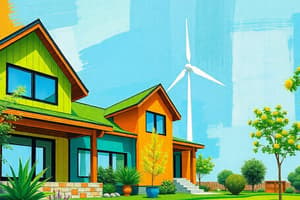Podcast
Questions and Answers
What is a primary challenge for the widespread adoption of sustainable building materials?
What is a primary challenge for the widespread adoption of sustainable building materials?
- Limited availability of certain materials in all regions.
- Reduced strength and durability of these materials compared to traditional options.
- The lack of skilled labor to work with sustainable materials.
- Higher initial cost compared to traditional construction materials. (correct)
What is meant by the "embodied energy" of a material?
What is meant by the "embodied energy" of a material?
- The amount of energy generated by the material itself.
- The amount of energy saved by using the material in a building.
- The amount of energy released when the material is recycled.
- The amount of energy required to manufacture and transport the material. (correct)
Which of the following materials would be considered a 'carbon-neutral' material?
Which of the following materials would be considered a 'carbon-neutral' material?
- Cross-Laminated Timber (CLT).
- Recycled Concrete.
- Geopolymer Concrete. (correct)
- Bamboo.
What is the primary benefit of using "Green Insulation" in buildings?
What is the primary benefit of using "Green Insulation" in buildings?
What is the significance of a material's "thermal performance" in the context of sustainable building?
What is the significance of a material's "thermal performance" in the context of sustainable building?
Which of the following is NOT a factor affecting the selection of construction materials?
Which of the following is NOT a factor affecting the selection of construction materials?
What is the primary purpose of "open specifications" in material selection?
What is the primary purpose of "open specifications" in material selection?
Which of the following best describes "life cycle cost analysis" in the context of construction materials?
Which of the following best describes "life cycle cost analysis" in the context of construction materials?
What is the main difference between a "closed" and an "open" material specification?
What is the main difference between a "closed" and an "open" material specification?
Which of the following principles of sustainable construction materials focuses on minimizing energy usage during material production?
Which of the following principles of sustainable construction materials focuses on minimizing energy usage during material production?
Which of the following is NOT a benefit of using performance specifications for construction materials?
Which of the following is NOT a benefit of using performance specifications for construction materials?
What is the key advantage of using materials with a long lifespan in construction?
What is the key advantage of using materials with a long lifespan in construction?
Which of the following is a common example of a sustainable material that promotes resource efficiency?
Which of the following is a common example of a sustainable material that promotes resource efficiency?
Flashcards
Bamboo
Bamboo
A lightweight, strong, and rapidly renewable material used in construction.
Life Cycle Assessment (LCA)
Life Cycle Assessment (LCA)
A method to assess the environmental impact of a product from creation to disposal.
Geopolymer Concrete
Geopolymer Concrete
Concrete made with industrial by-products instead of traditional cement, reducing emissions.
Carbon-Neutral Materials
Carbon-Neutral Materials
Signup and view all the flashcards
Thermal Performance
Thermal Performance
Signup and view all the flashcards
Designer
Designer
Signup and view all the flashcards
Maintenance
Maintenance
Signup and view all the flashcards
Material Specifications
Material Specifications
Signup and view all the flashcards
Closed Specification
Closed Specification
Signup and view all the flashcards
Open Specification
Open Specification
Signup and view all the flashcards
Life Cycle Cost Analysis
Life Cycle Cost Analysis
Signup and view all the flashcards
Resource Efficiency
Resource Efficiency
Signup and view all the flashcards
Energy Efficiency
Energy Efficiency
Signup and view all the flashcards
Study Notes
Construction Material Selection
- Designers are responsible for selecting construction materials that meet performance needs within budget constraints.
- Maintenance involves cleaning, preventing corrosion, and repairing materials.
- Material specifications document material characteristics to ensure performance, safety, and quality standards are met.
- Closed specifications identify specific products, while open specifications allow substitutions (e.g., "or approved equal").
- Performance specifications focus on material performance criteria (e.g., strength, appearance) allowing for the most economical selection.
- Factors influencing material selection include cost, aesthetics, weather conditions, popularity, and availability.
- Life cycle cost analysis considers the total cost of a material over its entire lifespan, including initial purchase, operation, maintenance, and disposal.
Principles of Sustainability in Construction Materials
- Resource efficiency prioritizes renewable and recycled materials to minimize reliance on finite resources.
- Energy efficiency reduces energy usage during material production.
- Durability and longevity reduces replacement frequency of materials.
- End-of-life management considers easy recycling or safe decomposition.
- Sustainable material examples include bamboo, recycled aggregates, CLT (Cross Laminated Timber), geopolymer concrete, and green insulation.
Environmental Benefits of Sustainable Materials
- Reduced carbon emissions due to lower embodied energy.
- Reduced waste through reuse and recycling.
- Improved energy efficiency through thermal performance characteristics.
Challenges and Opportunities for Sustainable Materials
- Challenges include higher initial costs and limited availability.
- Opportunities include innovations in materials, government incentives, and growing demand for sustainable construction.
Definitions of Key Terms
- Life Cycle Assessment (LCA): A process to evaluate the environmental impact of a material throughout its entire life cycle.
- Renewable materials: Naturally replenished resources like bamboo, straw, or timber.
- Volatile organic compounds (VOCs): Harmful chemicals emitted by certain materials, impacting indoor air quality.
- Carbon-neutral materials: Materials with a net-zero carbon footprint achieved through offsets.
- Thermal performance: Ability of materials to resist heat transfer, improving energy efficiency.
Studying That Suits You
Use AI to generate personalized quizzes and flashcards to suit your learning preferences.




